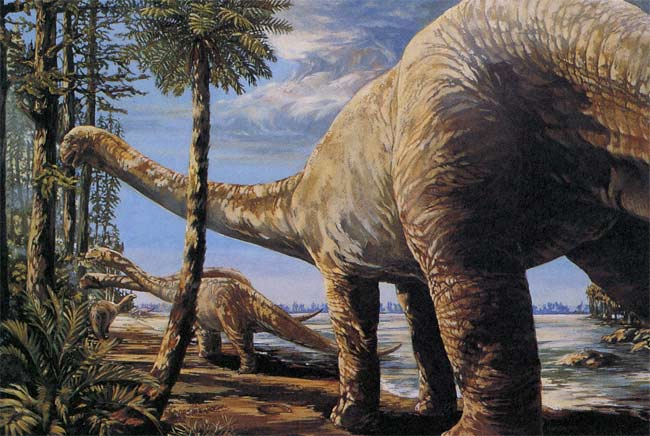Giant Dinosaurs Get Downsized

Some dinosaurs were the largest creatures ever to walk on land, including the classic long-necked, whip-tailed Diplodicus, but a new study suggests it and its many extinct brethren weighed as little as half as much as previously thought.
A new equation for calculating dinosaur mass based on skeletons found that scientists have been overestimating the girth of many dinosaurs. In some cases, the new calculations show that certain dinosaurs probably weighed about half what they were thought to weigh.
"They were still huge animals, I don’t think anyone would dispute that," said Geoffrey Birchard, a biologist at George Mason University in Virginia, and co-author of a paper published this week in the Journal of Zoology describing the new equation. "They might be half as big, but half of something that's really huge is still really huge."
For example, the behemoth Apatosaurus louisae, one of the largest of the dinosaurs, has been widely cited as weighing about 42 tons (38,000 kg). According to the new equation, these creatures actually weighed about 20 tons (18,000 kg), or less than half earlier estimates. Some other examples of old mass estimates compared to new:
- Giraffatitan brancai (Brachiosaurus) — old: 35 tons (32,000 kg); new: 18 tons (16,000 kg)
- Lourinhasaurus alenquerensis — old: 32 tons (29,000 kg); new: 17 tons (15,000 kg)
- Styracosaurus albertensis — old: 4.6 tons (4,200 kg); new: 3.6 tons (3,300 kg)
- Diplodocus sp. — old: 6.1 tons (5,500 kg); new: 4.4 tons (4,000 kg)
Birchard and collaborators Gary Packard and Thomas Boardman of Colorado State University realized there was something wrong with the original equation when they used it to calculate the weight of living animals, such as elephants, and found that it drastically overestimated their mass.
The scientists devised a new statistical model that can more accurately predict the mass of an animal based on the width of its bones.
"I like to explain it as a building that's built on pillars," Birchard told LiveScience. "The pillars have to get bigger around to get stronger to support a larger building. Well, the legs of an animal are the same thing, just pillars supporting the body."
Sign up for the Live Science daily newsletter now
Get the world’s most fascinating discoveries delivered straight to your inbox.
Another paper published last year in the journal Fossil Record used a different technique for estimating body mass, but calculated similar results to those of Birchard's team. That study was led by Hanns-Christian Gunga of the Charité-Universitätsmedizin Berlin.
If the new mass estimates are more reliable, they could have implications for understanding not just the weight of dinosaurs, but their whole biology.
"Think about an animal that big — they would have had to have certain amounts of muscle to move their mass," Birchard said. "If their mass is lower, the amount of muscle they would have had to have is significantly less. The amount of oxygen they would need could be interpreted to be much less because there's much less tissue to supply with oxygen."
Some studies suggest that dinosaur bones, like bird bones, had air cavities that made them lighter than they would appear. This feature could help explain how dinosaurs could weigh so much less than once thought.
- Gallery: Drawing Dinosaurs
- Dinosaur News, Information & Images
- Image Gallery: Dinosaur Fossils










